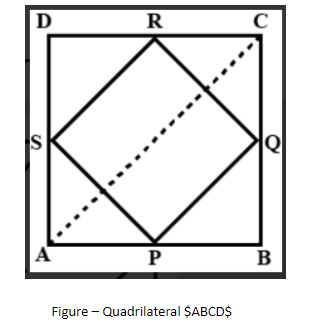
Show that the line segments joining the mid-points of the opposite sides of a quadrilateral bisect each other.
Answer
575.7k+ views
Hint:In the solution we will use the Midpoint theorem. According to the Midpoint theorem, when line segments join the mid-points of two sides of a triangle then that line segments are parallel to the third side and are half of it.
Complete step-by-step solution
Let us assume $ABCD$ is a quadrilateral where $P$, $Q$, $R$ and $S$ are mid-points on the sides. $AB$, $BC$, $CD$ and $DA$ respectively. The following is the schematic diagram of the quadrilateral.

In $\Delta DAC$,
The point $S$ is the midpoint of $DA$ whereas $R$ is the midpoint of $DC$. Therefore,
$SR\parallel AC$ and $SR = \dfrac{1}{2}AC$ ….…(1)
In $\Delta ABC$,
The point $P$ is the midpoint of $AB$ whereas $Q$ is the midpoint of $BC$. Therefore,
$PQ\;\parallel AC$ and $PQ = \dfrac{1}{2}AC$ …….(2)
On comparing equation $\left( 1 \right)$ and equation $\left( 2 \right)$. we get
$PQ = SR$ and $PQ\parallel SR$ ………(3)
From equation $\left( 3 \right)$ it can be concluded that in $PQRS$ one pair of opposite sides is parallel and equal. Hence $PQRS$is a parallelogram.
And, $PR$ and $SQ$ are diagonals of parallelogram $PQRS$.
Therefore, $OP = OR$ and $OQ = OS$ since diagonals of a parallelogram bisect each other.
Therefore, it is proved that the line segments joining the mid-points of the opposite sides of a quadrilateral bisect each other.
Note:Make sure to use the Midpoint theorem when any question is asking about a quadrilateral with midpoints and use Angle Side Angle similar (ASA) triangle properties to compare two triangles.
Complete step-by-step solution
Let us assume $ABCD$ is a quadrilateral where $P$, $Q$, $R$ and $S$ are mid-points on the sides. $AB$, $BC$, $CD$ and $DA$ respectively. The following is the schematic diagram of the quadrilateral.

In $\Delta DAC$,
The point $S$ is the midpoint of $DA$ whereas $R$ is the midpoint of $DC$. Therefore,
$SR\parallel AC$ and $SR = \dfrac{1}{2}AC$ ….…(1)
In $\Delta ABC$,
The point $P$ is the midpoint of $AB$ whereas $Q$ is the midpoint of $BC$. Therefore,
$PQ\;\parallel AC$ and $PQ = \dfrac{1}{2}AC$ …….(2)
On comparing equation $\left( 1 \right)$ and equation $\left( 2 \right)$. we get
$PQ = SR$ and $PQ\parallel SR$ ………(3)
From equation $\left( 3 \right)$ it can be concluded that in $PQRS$ one pair of opposite sides is parallel and equal. Hence $PQRS$is a parallelogram.
And, $PR$ and $SQ$ are diagonals of parallelogram $PQRS$.
Therefore, $OP = OR$ and $OQ = OS$ since diagonals of a parallelogram bisect each other.
Therefore, it is proved that the line segments joining the mid-points of the opposite sides of a quadrilateral bisect each other.
Note:Make sure to use the Midpoint theorem when any question is asking about a quadrilateral with midpoints and use Angle Side Angle similar (ASA) triangle properties to compare two triangles.
Recently Updated Pages
Why are manures considered better than fertilizers class 11 biology CBSE

Find the coordinates of the midpoint of the line segment class 11 maths CBSE

Distinguish between static friction limiting friction class 11 physics CBSE

The Chairman of the constituent Assembly was A Jawaharlal class 11 social science CBSE

The first National Commission on Labour NCL submitted class 11 social science CBSE

Number of all subshell of n + l 7 is A 4 B 5 C 6 D class 11 chemistry CBSE

Trending doubts
What is meant by exothermic and endothermic reactions class 11 chemistry CBSE

10 examples of friction in our daily life

One Metric ton is equal to kg A 10000 B 1000 C 100 class 11 physics CBSE

1 Quintal is equal to a 110 kg b 10 kg c 100kg d 1000 class 11 physics CBSE

Difference Between Prokaryotic Cells and Eukaryotic Cells

What are Quantum numbers Explain the quantum number class 11 chemistry CBSE




